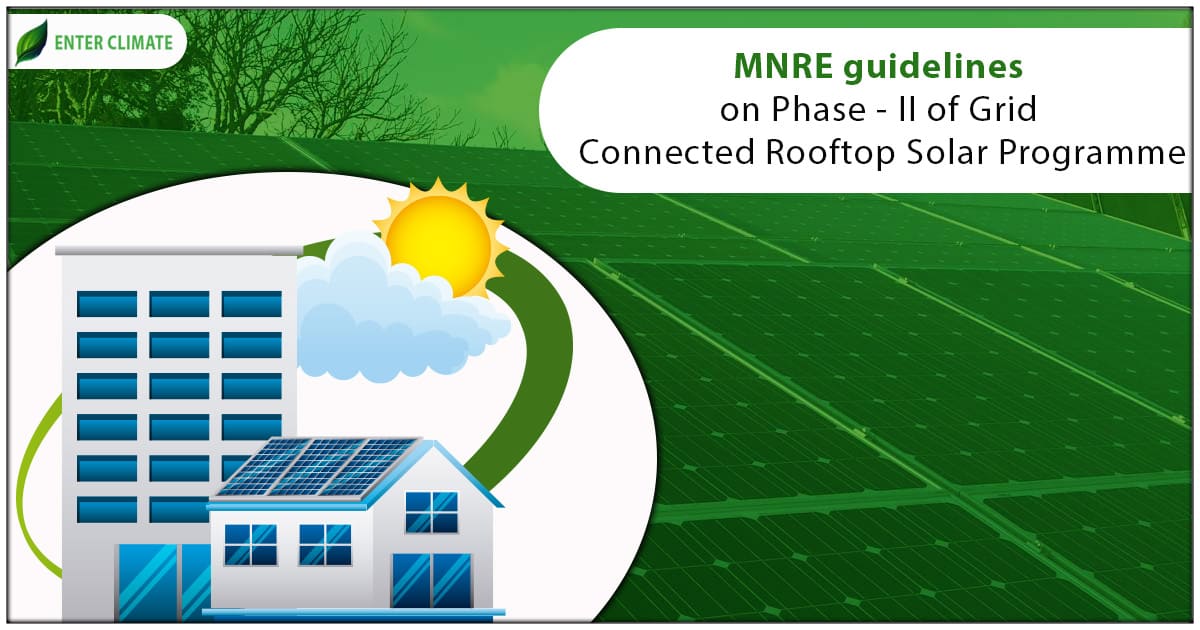MNRE guidelines on Phase – II of Grid Connected Rooftop Solar Programme
 15 Jun, 2023
15 Jun, 2023 
On February 19, 2019, the Ministry of New and Renewable Energy approved Phase – II of the Grid Connected Rooftop Solar Programme with a target of achieving a cumulative capacity of 40 GW from RTS plants by 2022. In October 2022, the Ministry extended this programme till the 8th of March, 2026. However, there were no financial implications and the program was to be implemented with the original outlay of Rs 11,814 crores for both components A and B of the program. The operational guidelines has been announced by the Ministry of New and Renewable Energy that provide details on the implementation of Phase II of the program. In this article, we will understand the guidelines released by the Ministry and how renewable energy businesses can benefit under this scheme
Phase II aims to encourage the adoption of grid-connected rooftop solar systems, empower DISCOMs to lead in implementation, increase awareness and capacity building, promote sustainable business models, and support domestic manufacturing of solar cells and modules. The program recognizes the benefits of rooftop solar in reducing transmission and distribution losses and managing daytime peak loads. In Phase II, DISCOMS and their local offices will serve as nodal points for RTS program implementation. DISCOMS will help in expanding RTS, as they have direct contact with end-users, provide installation approval, manage the distribution network, and handle billing interfaces with rooftop owners.
Guidelines Phase – II of Grid Connected Rooftop Solar Programme
Guidelines for implementing Phase II of the Grid Connected Rooftop Solar Programme, aiming to achieve a cumulative capacity of 40,000 MW from Rooftop Solar (RTS) Projects by 2026, are outlined as follows:
- Component-A focuses on installing 4,000 MW of grid-connected rooftop solar plants in the residential area, with financial assistance from the central government.
- Component-B offers incentives to distribution companies (Discoms) based on their achievement in installing additional grid-connected rooftop capacity across all sectors, up to an initial limit of 18,000 MW.
- India has committed to increasing the share of non-fossil-fuel sources in its installed electric power capacity to 40% by 2030.
- RTS plants are installed on building roofs and contiguous open land within premises with valid electricity connections provided by distribution utilities/companies (DISCOMS). RTS plants benefit DISCOMS by reducing transmission and distribution losses and helping manage daytime peak loads.
- On December 30, 2015, the government approved the “Grid Connected Rooftop and Small Solar Power Plants Programme” to install 4,200 MW of RTS plants by 2019-20, with 2,100 MW receiving central financial assistance (CFA) and the remaining 2,100 MW without CFA.
- State Nodal Agencies (SNAs), Solar Energy Corporation of India (SECI), Public Sector Undertakings (PSUs), and other Government Agencies (GAs) are implementing the sanctioned RTS projects under this program.
Aim and Objectives of Phase-II of Grid Connected Rooftop Solar Programme
The goals and objectives of Phase – II of the Grid Connected Rooftop Solar Programme are as follows:
- To encourage the adoption of grid-connected rooftop solar (RTS) systems in various consumer segments, including residential, institutional, social, government, commercial, and industrial sectors.
- To empower DISCOMs to take a leading role in driving the rapid deployment of RTS.
- To increase awareness, capacity building, and human resource development in the RTS sector.
- To promote sustainable business models for the implementation of RTS projects.
- Achieve an additional RTS capacity of 38,000 MW in the country by March 2026, comprising 4,000 MW in the residential sector with central financial assistance and 34,000 MW in other sectors (such as social, government, educational, public-sector units, statutory/autonomous bodies, private commercial, and industrial sectors) through suitable incentives for DISCOMs.
- Encourage domestic manufacturing of solar cells and modules to support the growth of the RTS sector.
Strategy
Phase – II of the Grid Connected Rooftop Solar Programme will be implemented through DISCOMs, ensuring easier access for consumers. Central Financial Assistance (CFA)1 will be provided to homeowners and Group Housing Societies for installing rooftop solar systems. DISCOMs are encouraged to create customer-friendly environments by streamlining the approval process and incorporating enabling provisions in their regulations. In cases where DISCOMs need more expertise in solar energy, they can seek support from State Nodal Agencies (SNAs) responsible for promoting renewable energy in their respective states/union territories.
- Implementation arrangement: During Phase-I of the rooftop solar programme, several challenges were identified, such as multiple tenders causing delays, involvement of multiple stakeholders, lack of uniform regulations, and low awareness among potential beneficiaries. To address these issues and streamline the installation process, Phase – II of the Grid Connected Rooftop Solar Programme will be implemented through DISCOMs and their local offices. The key components of Phase II include setting up 4,000 MW of grid-connected rooftop solar projects in the residential area with CFA and providing incentives to DISCOMs based on their achievements in installing the initial 18,000 MW of rooftop solar plants.
Component A of Phase – II
Installation of 4,000 MW of grid-connected rooftop solar projects in the residential area with Central Financial Assistance (CFA) in Phase – II of Grid Connected Rooftop Solar Programme: In states and union territories where the residential sector receives subsidized electricity, homeowners are less inclined to adopt rooftop solar systems without a cost-reducing CFA mechanism. The CFA structure for rooftop solar (RTS) has been restructured to address this. Higher CFAs of up to 40% will be provided for RTS systems with up to 3 kW capacity. For systems above 3 kW and up to 10 kW, the CFA of 40% will only apply to the first 3 kW, while the remaining capacity will have a CFA limited to 20%.
- Group Housing Societies/Residential Welfare Associations (GHS/RWA) will receive a CFA of 20% for installing RTS systems for supplying power to common facilities.
- The Ministry of New and Renewable Energy (MNRE) will allocate capacity for the installation of rooftop solar (RTS) systems in the residential sector by DISCOMs (Distribution Companies) in the upcoming year. One of the factors considered for capacity allocation will be the demand raised by DISCOM and the capacity needed to fulfil the state’s solar Renewable Purchase Obligation (RPO), as notified by the Ministry of Power.
- DISCOMs will be required to submit yearly online proposals through MNRE’s SPIN portal by March, with an exception for the year 2019-20, allowing submission within one month from the publication of operational guidelines. MNRE may also directly request demand from DISCOMs instead of going through the SPIN portal. States/UTs that provide additional subsidies or benefits beyond the Central Government’s Central Financial Assistance (CFA) will be given preference.
If the systems do not meet the required standards, are nonfunctional due to poor installation quality, or fail to comply with the Annual Maintenance Contract (AMC), the implementing agency/Ministry reserves the right to blacklist the vendor. Blacklisting may include the following:
- Disqualification from participating in tenders for government-supported projects.
- If the director(s) of the firm/company joins another existing or starts/joins a new firm/company, the company will be automatically blacklisted.
- Beneficiaries interested in installing RTS plants will submit their applications online or to the local office of the respective DISCOM if an online portal is unavailable. DISCOMs will assist consumers in all activities related to CFA approval, commissioning, and connectivity of RTS plants through transparently enlisted vendors/manufacturers/system integrators.
- The entire process of receiving, processing, and approving proposals will be IT-enabled, except in DISCOMs, where an online portal is not developed.
- After deducting the CFA portion, consumers will only pay the remaining amount to the empanelled vendor. The CFA will be disbursed through DISCOMs to the empanelled vendor after the commissioning and inspection of the RTS plant. DISCOMs must adhere to the suggested timelines for all processes, as defined in the annexure, and ensure strict compliance with them.
Component B of Phase – II
Phase – II of Grid Connected Rooftop Solar Programme DISCOMs will receive performance-linked incentives to compensate for the additional expenses incurred in implementing the program, such as manpower, infrastructure, capacity building, and awareness. These incentives will be provided based on the capacity of solar rooftops added by the DISCOMs in their distribution area, exceeding 10% of the base capacity installed in the previous year. It’s important to note that these incentives will not apply retrospectively. These incentives aim to support DISCOMs in creating a conducive environment for the efficient implementation of rooftop solar projects in their respective areas.
- The responsibilities of DISCOMs will include allocating dedicated manpower for rooftop solar implementation, conducting rooftop assessments, managing the bidding process to select system integrators at specified rates, conducting technical studies, upgrading ERP systems/components, delivering prompt services to rooftop solar consumers, inspecting and monitoring solar plants online, managing an online database of commissioned capacity, conducting consumer awareness and publicity campaigns, ensuring the availability of net meters, providing grid connectivity, and enhancing the capacity building of their officers and staff.
- The incentives will be awarded based on the incremental capacity of rooftop solar installations by the DISCOMs within a 12-month (financial year-wise) until the duration of the program.
Roles and Responsibilities of Stakeholders
Phase – II of Grid Connected Rooftop Solar Programme of Roles and responsibilities of stakeholders is as follows:
- MNRE will allocate capacity for the upcoming year to different DISCOMs based on factors such as demand, capacity required for meeting solar Renewable Purchase Obligation (RPO), any additional subsidy/benefit provided by the State/UT (Union Territory) over and above the CFA provided by the Central Government, and the performance of the State/UT/DISCOM in the past.
- MNRE will release funds to DISCOMs to disburse CFA to vendors installing rooftop solar plants in the residential sector.
- Participating government-owned DISCOMs may receive advance CFA of 30% of the total CFA amount, and Private DISCOMs will receive CFA on a reimbursement basis. CFA will be released incrementally for the installed capacity without waiting for the entire sanctioned capacity. Funds may be released upon receipt of the Project Installation.
Conclusion
The guidelines for implementing Phase II of the Grid Connected Rooftop Solar Programme provide a comprehensive framework to achieve the ambitious target of installing 40,000 MW of rooftop solar capacity within 2022. The program emphasizes the involvement of distribution companies (DISCOMs) as key stakeholders in driving the adoption of rooftop solar systems across various sectors. It is recommended to take expert advice while implementing Phase – II of the Grid Connected Rooftop Solar Programme to ensure that all the compliances are in place.
FAQ
The key components of a Grid Connected Rooftop Solar PV system include Solar PV Modules/Solar Panels, an Inverter, a Module mounting structure, Bi-directional Meters, and a circuit breaker, among others.
Approximately 10 square meters of roof area is required to install a 1 kW grid-connected rooftop solar system. For instance, installing a 5 kW system would require around 50 square meters of roof space.
The main benefits of a grid-connected PV system are its simplicity, relatively low operating and maintenance costs, and reduced electricity bills. However, it is essential to note that enough solar panels must be installed to generate excess power.
Grid Connected Rooftop Solar Programme allows consumers to generate their own electricity, reducing dependence on the grid and lowering electricity bills. By harnessing solar power, the programme helps reduce greenhouse gas emissions and dependence on fossil fuels. It also enables consumers to generate their own electricity, giving them greater control over their energy production and reducing reliance on external sources.
Component, A of Phase II, focuses on installing 4,000 MW of rooftop solar in the residential sector, providing financial assistance from the central government. Component B incentivizes DISCOMs based on their achievements in installing additional rooftop solar capacity.
Read our Article: How To Start A Renewable Energy Business In India?













